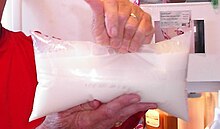Milk hose
A milk hose or a milk bag is packaging for fresh milk made of plastic film . Due to the shape of the packaging, this milk is also known as hose milk .
description
In the original version of the milk hose , which was in use in East and West Germany from the 1960s to the 1990s, the packaging consists of a tube made of co-extruded two-layer polyethylene film , which is sealed at both ends with a weld seam. The plastic hose with a capacity of 1 liter can be transparent or opaque and is usually printed with the brand logo and other information about the content. For pouring, place the bag in a plastic tubular bag and then cut off the upper corners with scissors.
The newer version, which has been marketed since the 2000s and consists of a mixture of plastic and chalk, has a folding base so that the milk tube or milk bag can stand without an additional receptacle. A separate air-filled tube on the side of the bag serves as a handle. The spout is opened by tearing off a corner along a pre-cut groove.
history
Germany
The packaging of fresh milk in milk tubes first appeared in Germany in the late 1960s. Until then, milk had either been sold in bulk and individually filled into milk cans or, with the increasing number of self-service shops, packaged in glass bottles .
The first milk tubes in West Germany were made of pure polyethylene and were extremely light and thin compared to glass bottles. Due to the low material consumption and the fact that pure polyethylene can be easily recycled, milk hoses have a better ecological balance than today's Tetra Paks .
In the GDR, the milk hoses manufactured in the VEB Petrolchemisches Kombinat Schwedt from the 1970s , which were also made of polyethylene and allowed packaging in 0.5 and 1 liter, were widely used for similar reasons (easy transport, low production costs and raw material consumption). The associated tubular bag pails were produced by VEB Plastververarbeitungwerk Schwerin in three different versions. In addition to milk tubes, glass bottles for milk also remained in use in the GDR; the production of metal milk cans there ended in 1967.
In West Germany, regional dairies in particular valued the milk tubes as light and inexpensive packaging. However, milk hoses were not popular with customers. In many cases the bags tore open during transport to the supermarket or on the way home: “Buying milk meant putting cold, jellyfish sloshing milk tubes in a tub and feeling for a dry one.” In the 1980s, more stable film tubes came onto the market consisted of multiple layers, however, consumers preferred the ease of use of the composite paperboard (such as Tetrapak ) packaging , which now has the largest market share.
Until 1997 the milk hoses still achieved a market share of 12%. At the turn of the millennium, however, this type of packaging disappeared almost completely from supermarkets. The market share fell to 1% by 2004 and was even lower thereafter.
The new stable milk bags have been in use by regional dairies , for example in Baden-Württemberg, Brandenburg and Lower Saxony , since the 2000s , but it is a niche product with only a small market share. The milk hose from the Hemme dairy in Lower Saxony was awarded the German Packaging Prize in 2014 .
Switzerland
In Switzerland, classic milk hoses with two welds are available from the Migros chain in some regions . Migros uses this form of packaging for the sale of regionally produced organic milk, for example from the Basel area .
Other countries
Milk tubes were also popular in other countries in the 1960s and beyond. Almost everywhere, however, the milk hose has been detached from the milk carton. Milk tubes are still widely used in Argentina , Israel , Canada and Hungary .
Web links
Individual evidence
- ↑ FOCUS Online: Berlin: Words of the 70s and 80s: pedestrian zone and forest dieback. Retrieved November 25, 2019 .
- ↑ Susanna Stock: Cases with many functions . In: Kunststoff International . No. 5 , 2010, p. 97 .
- ↑ a b c Katja Böhme, Andreas Ludwig (ed.): Everything made of plastic, promise and use in the GDR . Cologne [u. a.] 2012, ISBN 3-412-20966-X , p. 128-33 & 229-230 (this publication appeared for the exhibition of the same name in the documentation center of everyday culture in the GDR).
- ↑ Milk in Brandenburg. (PDF) Retrieved November 24, 2019 .
- ↑ Inhibit milk: Our milk bag. Retrieved November 24, 2019 .
- ↑ Dr. Andrea Fink-Keßler: The history of direct milk sales . In: AgrarBündnis eV, Rheda-Wiedenbrück (Ed.): The Critical Agricultural Report 2002 . ISBN 3-930413-21-3 , pp. 306-308 ( make-sense.org [PDF]).
- ↑ a b c d e Carolin Wahnbaeck: Bagged milk: What happened to the milk tube? In: Spiegel Online. November 27, 2015, accessed November 24, 2019 .
- ↑ Milk cartons from the VEB Petrolchemisches Kombinat Schwedt , accessed on November 26, 2019
- ↑ German Packaging Award, Awarded 2014: Hemme Milch. Retrieved November 24, 2019 .
- ↑ Migros | Whole milk past bag. Accessed December 1, 2019 (Swiss Standard German).
- ^ Patricia Aguirre: The culture of milk in Argentina . In: Anthropology of food . No. 2 , 2003, doi : 10.4000 / aof.322 .
- ^ So we drink milk from bags. Does that make us weird? | The Star. Retrieved November 24, 2019 .




